Resources:
Amplified Concrete Solutions (US Supplier Concrete Cloth)
Cozy Caverns Steel Underground Shelters
Bury’able Tubular Shelters
Radiation Shelters FAQ
FEMA Radiation Safety in Shelters (HTML)
FEMA Radiation Safety in Shelters (PDF)
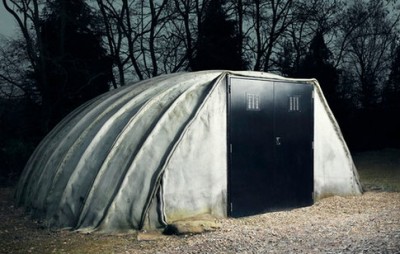
Concrete Canvas is a nifty invention, and this building really does go up with just an air pump and some water, but north of $25,000, there are better buys for a more sound fallout shelter.
Answer:A $25,000 inflatable concrete building. Just add water.
Question: What is a Concrete Canvas Shelter?
Believe it or not, this is not a joke, and when I encountered this product it reminded me that I have been meaning to discuss the qualifications for a proper nuclear fallout shelter for some time. But I have to admit, of all the survival preparations I’ve written about for this column, this is one of very few I have not actually worked out for myself. That is why I found this product so interesting. You carry it to where you want a concrete shelter, inflate it with an electric pump, and sprinkle it with water. Instant solid concrete shelter, with steel blast doors! Crazy right? If you have the funds, this $25,000-$35,000 product is a good start towards a sound above ground fallout shelter, but as I’ll explain, it isn’t going to protect you from harmful radiation by itself. Check out the video it’s a nifty thing.
To back up one step, I have to explain why I’m a fool for not having a proper fallout shelter yet, and if you take the coming collapse seriously, and you don’t have one either, you are too!
Over the more than a year of this column, I’ve noticed that the radiation articles here always get the least amount of clicks. I think it is because we have all been conditioned to think that only fools worry about nuclear war. Going back to the 60s, and right up through the 80s, most of us grew up in an environment of the “Cold War.” Ad nauseum we were fed stories of “nuclear winter” and “mutually assured destruction.” Then the Berlin Wall came down and all of a sudden we were sending billions in aid to the “former” Soviet Union, who by the way never stopped pointing their nukes at us. Then 911 happened, and “Islamic Extremists” became the new bogeyman. These days, nobody thinks they need a fallout shelter because clearly “mutually assured destruction” has worked, and it will keep Russia and China from starting a nuclear war. Of course America is waaay too righteous to ever do a first strike.
For the purpose of getting us all to finally build a fallout shelter, I’m willing to put all of the nuclear war stuff aside, just for the sake of conversation. I’ve seen so much evidence that the old saying “you can’t fool all of the people all of time” isn’t at all true, for all I know, Russia has been faking all along that they have nukes at all. But from available evidence, nuclear power is real, and the nuclear plants that we know have melted down, Chernobyl and Fukushima, are pretty good evidence that not only are nuclear plant meltdowns dangerous to the surrounding areas, they also send clouds of radioactive fallout all over the globe.
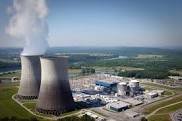
I am willing to put aside all of the arguments for why we could have a nuclear war, one caused by a US first strike, and consider a fallout shelter just for the danger of nuclear power plants. Who will run them after the collapse? There is no off switch.
According to the U.S. Energy Information Administration, there are currently 61 commercial nuclear power plants in the US. If you, like me, think that we are in for a big reality shakeup at some point in the near future, who exactly is going to show up to work to run them when people are killing each other in the streets over food? Remember the cops and firemen who went AWOL after Katrina? Does anyone think that all of those people who know how to keep a nuke plant running will show up to work if/when there is pandemonium in America? And even if they do show up, how much food and water do you think they store at said nuke plants? Um, like none most likely.
Without a constant monitoring and adjustment of the cooling systems, nuke plants melt down. And while I have never seen the mechanics of a reactor in person, from everything I have read, even without any explosions or damage, there is no off switch on a nuclear reactor, period. Yes, nuke plants can be “decommissioned” by stopping the reaction and removing the fuel rods, but that takes a long time, a lot of money, and again, a whole bunch of people who know how to do that.
This isn’t some disaster movie with a happy ending. Eventually, all of those reactors are going to blow. And we know from the current mess in Fukushima, once they do all bets are off as to how you can get them to stop leaking radiation. The radiation in some of the Fukushima reactors is so dense that robots can’t even work near them. Our media of course doesn’t report on it, but Fukushima is a mess, and it one of the factors killing the Pacific ocean. Even Chernobyl made it back into the news recently because the sarcophagus covering the meltown is leaking again, and must be recapped.
All of us at some point are destined to be downwind from a nuclear power plant that is leaking radiation. Is it going to be in our lifetime, or are the powers that be going to be able to maintain a semblance of this false reality for a few more generations before it all breaks down? I don’t know, but it is worth considering what it would take to live in a radiation infected world.
I am not going to get into the subject of measuring radiation in the air or in food for this article. I have covered both high and low level radiation meters at length already, at both a high and low budget. We are all going to need to know when radiation could possibly effect our health. It is not a simple subject and there are not real simple answers, but if you follow my instructions you’ll get the best buy on useful tools that I have found to date.
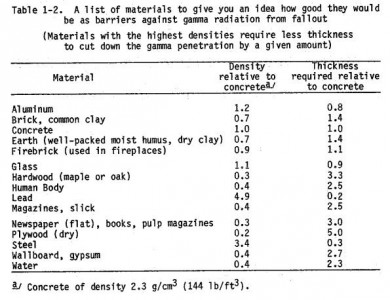
This is a comparison chart from FEMA Radiation Safety in Shelters on different materials and their relative thickness to concrete that you need to attenuate as much radiation. It is all about pure weight.
For this article I would like to focus on blocking, or attenuating radiation. I’ve covered this subject before, because it isn’t what people think. Lead doesn’t protect you any better from radiation than cement, dirt, or even wood. You just need less volume of it. Radiation attenuation all boils down to actual weight of material between you and the radiation. According to the most common reference, FEMA’s 1983 book, Radiation Safety in Shelters, it takes .2x as much lead in thickness to match regular old concrete. So if you wanted to protect yourself with 10″ of concrete, which is considered the minimum for direct radiation fallout of alpha and beta particles, as well as a heavy load of gamma, you would need 2″ of lead to match that. An 80lb bag of concrete is about $5 at Home Depot. Of lead it would be many times more expensive.
This is why the $25,000 Concrete Canvas building is neat, but really isn’t that cost effective. If you live at elevation, or where the water table isn’t very high, you can dig a hole, lay felled trees over the top, then cover those trees with bags of concrete and you’ll have a great fallout shelter for cheap. Where I live in Florida we can’t do that because the water table is generally no more than 2 feet from the surface. But even here, a simple concrete block building big enough for several people and food and water wouldn’t be that expensive, by a fraction of Concrete Canvas. The only thing that you need to be realistic about is that we are talking about actual weight vs. direct attenuation, so a lot of protection means a lot of shlepping.
The Concrete Canvas building is only a couple inches thick from what I can tell. As an above ground shelter it would be great, but you’d have to cover it with either a dirt mound or bags of cement if you expect to use it as a fallout shelter. This would also be true of a used shipping container, which generally you can pick up for under $3,000. The difference with Concrete Canvas is that you can discretely carry it into your bugout location in the back of a pickup truck, whereas a shipping container tends to be not very discrete.
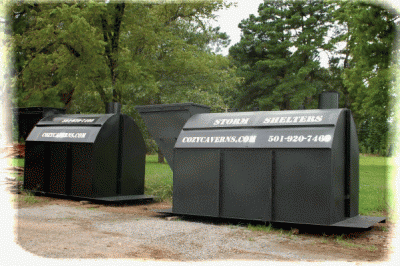
Of all the bury’able hurricane shelters, Cozy Caverns seem to be the best for the money from a radiation perspective. The door is offset so you could build a small concrete above ground hat for it. They also have a shelf on the bottom to prevent the building from floating up.
I have also looked into modular underground hurricane shelters, and they are extremely promising in comparison to just about all other options. The best I have found for the money are Cozy Caverns in Arkansas. They have a 6×12 steel welded structure for under $5,000 if you paint it yourself, and it has an offset doorway hatch. You could build a small concrete above ground hat for the doorway, and I don’t think you could do better. In Indiana I found Integrity Shelters that are fiberglass for $5,000-$10,000, and some of them have an offset doorway, which from a radiation perspective would be better. The Granger Plastics shelters also are very popular in hurricane country, but they seem to be a little more money for less space.
Time and money are the only things preventing from making your shelter more elaborate. Some people design their fallout shelters more than ten feet underground so that they can potentially withstand a ground zero nuclear blast. People have bought retired missile tubes from the government for fallout shelters. If you are reading this column, my guess is that you aren’t in that financial reality, and that like me, you’d prefer to build something that is effective and affordable, but that may not have a lot of bells and whistles.
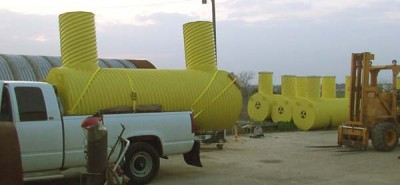
These shelters are made to bury and stay in for the first couple days after a nuclear explosion, and they are very reasonable, $3200 FOB Texas, but I wouldn’t want to try to live in them part time when radiation clouds are periodically passing by over the course of years.
I think that far more valuable than being able to make it through a nuke hit is to construct a shelter that can be a long term living space, preferably above ground actually. I’m not talking about a situation where you are in a radiation hotspot from a nuclear war. If nuclear bombs pop, there are going to be areas that are unlivable for 25 years or more, and there is little that you can do to attenuate that. There will also be some regions that are downwind from blast sites and that will stay “hot” for long periods of time, and they will also be unlivable. Likewise anywhere near a nuke plant that has melted down. What if you are 200 miles from the nearest meltdown, and that you get a few days a month of heavy fallout, but otherwise, your radiation levels are within the range of survivable?
For that you’ll need a building with a thick cement roof, and preferably thick cement sides. Besides the potential blast benefits, the reason underground has always been the most popular design for fallout shelters is because radiation, like other waves, doesn’t really curve much. Underground, you don’t have to deal with gamma radiation from a source that is above ground. Alpha and beta particles that fall from clouds will emit their own gamma radiation, but as long as you have that cement roof, for the most part you’ll be protected. A steel sided shipping container that is above ground is best buried in a thick mound of dirt, or build cement walls next to it.
Before you drop your shelter, whether it be a cement building you construct, a shipping container, or even something like this Concrete Canvas building, it would be really smart to lay some underground water lines, air lines, and even electric lines to what will become holes in your flood. If you can drop it right on a wellhead, even better. A 200′ run of 4″ PVC to a secret air hole isn’t that expensive, and that much horizontal run will all but eliminate any need for filtration. Radiation particles are heavy and once out of a swirling air current fall straight down. People here have mentioned that 4″ is too small for a natural flow of air back and forth and such a system would probably require a blower. It would be assumed that nobody reading this article would just “go do that” without research of their own.
I’ve had commenters on this column say “I’d never lock myself in a bunker because all they have to do is plug up your air hole!” Well yea, the air hole they know about. But if you do it right your shelter will either never be seen, or will at the very least look like a storage shed. So many people are going to die when this finally happens that the zombie hoards we have all seen in the movies I don’t think are ever going be materialize. Most people think preppers are crazy, and most people are just going to starve to death after pandemonium hits. Those of us who saw the writing on the wall and put away some food and water resources will be able to contact each other on our Ham radios if we survive, and the world will go on in some semblance of what it was. That’s a best case scenario I think. Most likely the rich and famous with the real resources are going to hunker down for a couple of decades and see what happens next if even they survive.
Based on my research, you can build a viable radiation shelter for less than the cost of a family vacation. That should be an action item for those of us that can pull it off if we want to take actual survival in the real new world that is coming seriously. I hope we have some time. If we make it to this winter it probably means we have at least another year to prepare, and then we’ll do this all over again next summer, as I explained in my Jade Helm article. Now that I finally understand what is really going on, I wish I could see a happy ending, but I don’t. It looks like the powers that be are setting up a whole bunch of things to burn down at the same time, so that there is no way that people can band together and hold them accountable for what they’ve done to us. I don’t want to regret that I didn’t at least do what I could. I’m going to try to build a realistic fallout shelter this winter.